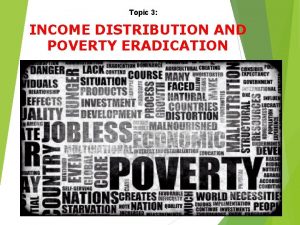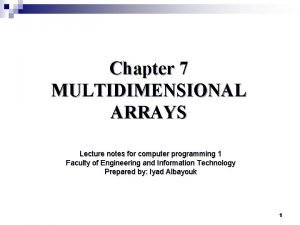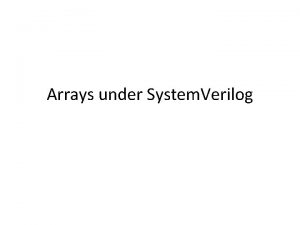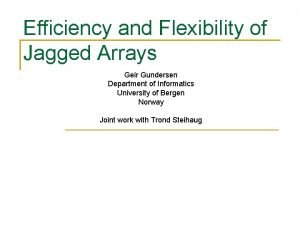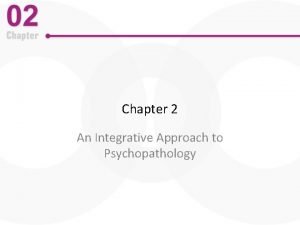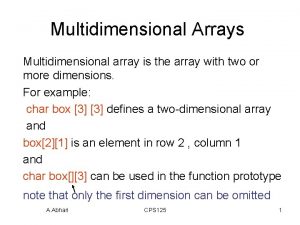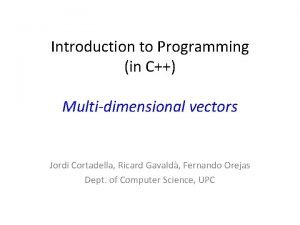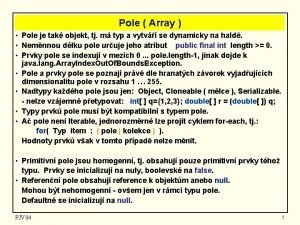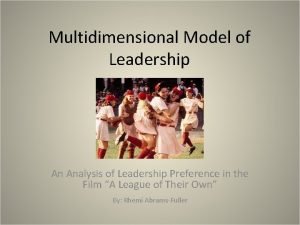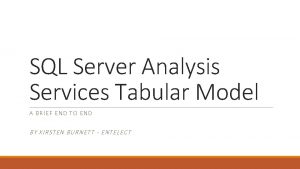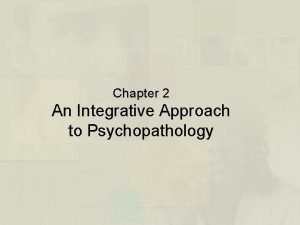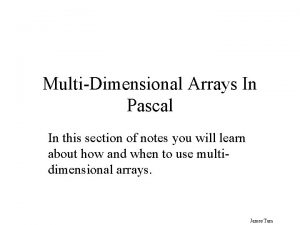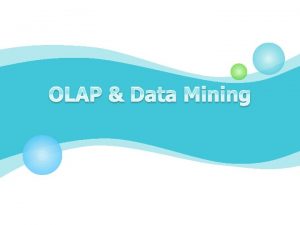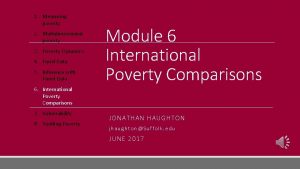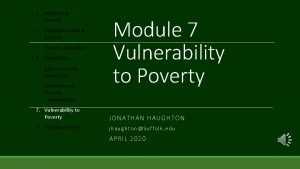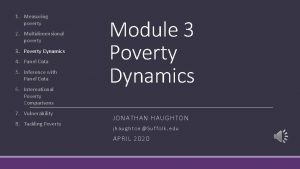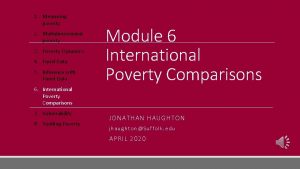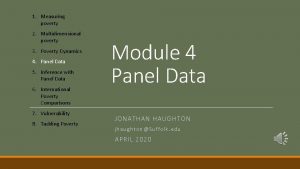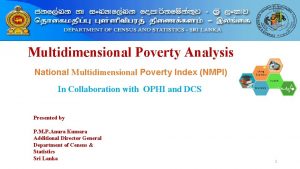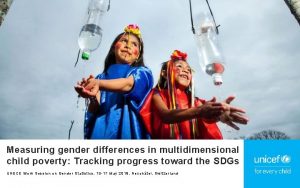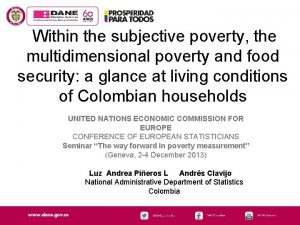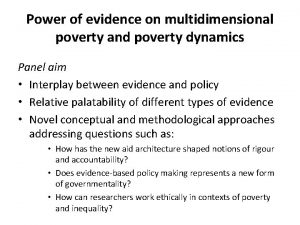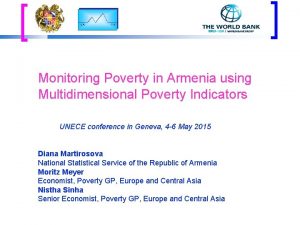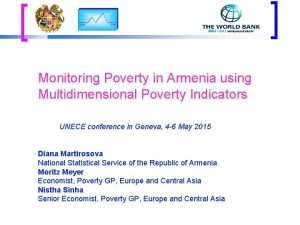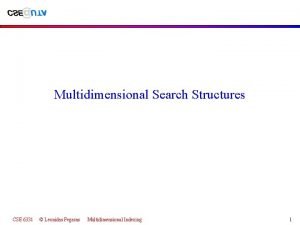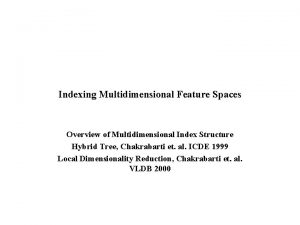1 Measuring poverty 2 Multidimensional poverty 3 Poverty
















- Slides: 16

1. Measuring poverty 2. Multidimensional poverty 3. Poverty Dynamics 4. Panel Data 5. Inference with Panel Data 6. International Poverty Comparisons 7. Vulnerability 8. Tackling Poverty Module 5 Inference with Panel Data JONATHAN HAUGHTON jhaughton@Suffolk. edu APRIL 2020

Objectives 1. Explain the essential ideas and vocabulary of regression analysis. 2. List and explain the main regression problems, including i. iii. iv. v. vii. April 2020 Measurement error Omitted variable bias Simultaneity bias Sample selectivity bias Multicolinearity Heteroskedasticity Outliers 3. Show panel data can help address some of these problems 4. Outline the key ideas underlying impact evaluation 5. Explain how impact evaluation can be more powerful with panel data, and illustrate this with an example from Thailand JH: POVERTY MEASUREMENT COURSE 2

Regression 1 Fit a line to data ◦ As here, Vietnam 1998 ◦ Engel curves ◦ Linear ◦ Food spending/cap = 1. 188 + 0. 22 (spending/capita) ◦ Quadratic ◦ F/cap = 0. 853 + 0. 30 (spend/cap) – 0. 0021 (spend/cap)^2 April 2020 JH: POVERTY MEASUREMENT COURSE 3

Vocabulary Intercept/constant Coefficients Dependent variable/Y variable/Left-hand variable/Outcome variable Independent variables/regressors/covariates/Right-hand variables Error (unobserved) ◦ Mean zero; identically & independently distributed True equation; estimated equation Residual (observed): April 2020 JH: POVERTY MEASUREMENT COURSE 4

Example R 2 = 0. 47. Goodness of fit. Adjusted R 2 even better Coefficient signs as expected Consumption/capita: in logs. t-statistics shown. [>2 ≈ “significant at 5%”]. P-values are nice. Phnom Penh variable is binary ◦ Dependency ratio: (young + old)/(prime age) ◦ Femaleness: % aged 15 -60 who are female. Positive coefficient April 2020 JH: POVERTY MEASUREMENT COURSE 5

Regression problems: Measurement error: y = a + b. X + ε ◦ In Y: no bias, but poor fit ◦ In X: estimate of b biased toward 0 Omitted variable bias ◦ True: Child health = a + b Mum. Ed + c Mum. Ability Estimated: Child health = a + b Mum. Ed If ed, ability, correlated, estimate of b is too high April 2020 JH: POVERTY MEASUREMENT COURSE 6

More regression problems Simultaneity bias ◦ E. g. Child health = a + b Nutrient intake ◦ But which comes first? Feed the weak or the healthy? Sample selectivity bias ◦ E. g. Only observe wages for those who work ◦ Solution: Two steps (Heckman) Multicolinearity ◦ Some X variables are intercorrelated ◦ Hard to get accurate coefficient estimates ◦ Telltale sign: high R 2 but almost no coefficients statistically significant April 2020 JH: POVERTY MEASUREMENT COURSE 7

Yet more regression problems Heteroskedasticity ◦ Errors do not have constant variance ◦ Coefficients not biased; but standard errors inefficient April 2020 JH: POVERTY MEASUREMENT COURSE 8

Regression Problems Again Outliers ◦ Typo or truth? April 2020 JH: POVERTY MEASUREMENT COURSE 9

Panel data can be helpful Rice output = a + b fertilizer + c ability + ε Ability unobservable, so estimate ◦ Rice output = a + b fertilizer + w But estimate of b is likely overstated. Use panel data: ◦ ◦ April 2020 Differencing washes out “ability”, allows an unbiased estimate of b Very useful, but only works if ability is time-invariant. JH: POVERTY MEASUREMENT COURSE 10

Impact Evaluation Purpose: quantify the impact of a project or policy ◦ E. g. Does microcredit raise incomes Complex; requires construction of a counterfactual Gold standard: Randomized Controlled Trial ◦ Randomly select beneficiaries (and controls) ◦ Collect baseline data ◦ After intervention, collect data again; compare outcomes between treated and controls April 2020 JH: POVERTY MEASUREMENT COURSE 11

Powerful: Double Differences Panel data with pre- and post-treatment ◦ E. g. (30 – 10) – (21 – 14) = 13 April 2020 JH: POVERTY MEASUREMENT COURSE 12

Can combine with regression Error: time-invariant and innovation components Sweeps away effects of variables, including unobservables, that do not vary over time Jalan and Ravallion (1998): Poverty alleviation program in China ◦ Double differencing biased; keep variables for initial conditions that influence program placement April 2020 JH: POVERTY MEASUREMENT COURSE 13

Example: Thailand Village Fund Village-run microcredit; any impact on expenditure or income per capita? Rural panel, Socio-Economic Surveys, 2002 and 2004 T = treatment = borrow from Village Fund X variables include household variables (e. g. age of head, education of head, no. of adults). Y is log of expenditure (or income) per capita Estimates of γ: ◦ Expenditure: 3. 5% (s. e. 1. 5%; p-value 0. 02) ◦ Income: 1. 4% (s. e. 1. 8%; p-value 0. 44) April 2020 JH: POVERTY MEASUREMENT COURSE 14

Extensions There may be time-varying unobserved heterogeneity, biasing the coefficient on T ◦ E. g. Local conditions may change over time Solution 1: Interact treatment with time-varying variables ◦ Khandker (2006): Microcredit in Bangladesh Solution 2: Arellano-Bond dynamic lagged-dependent-variable approach ◦ See Jalan and Ravallion (1998), mentioned above April 2020 JH: POVERTY MEASUREMENT COURSE 15

Reading Haughton & Khandker (2009). ◦ Handbook on Poverty and Inequality. Chapter 14; 13 (pp. 256 -270). World Bank, Washington DC. Khandker, Koolwal, & Samad (2010) ◦ Handbook on Impact Evaluation, World Bank, Washington DC. Haughton & Haughton (2011). ◦ Living Standards Analytics, Springer, New York. Chapters 2 (Regression) and 12 (Impact Evaluation) Boonperm et al. (2013) ◦ Does the Village Fund matter in Thailand? Evaluating the impact on incomes and spending. Journal of Asian Economics 25: 3 -16. Cameron & Trivedi (2009) ◦ Colin Cameron & Pravin Trivedi. Microeconometrics Using Stata Press. April 2020 JH: POVERTY MEASUREMENT COURSE 16
 Relative poverty
Relative poverty Processing multidimensional array
Processing multidimensional array Verilog array indexing
Verilog array indexing Jagged array
Jagged array Integrative approach to psychopathology
Integrative approach to psychopathology Multidimensional array
Multidimensional array One-dimensional vs multidimensional models
One-dimensional vs multidimensional models Perbedaan array 1 dimensi 2 dimensi dan multidimensi
Perbedaan array 1 dimensi 2 dimensi dan multidimensi Multidimensional calm test
Multidimensional calm test Multidimensional vector c++
Multidimensional vector c++ List index out of bounds (0)
List index out of bounds (0) Multidimensional model of leadership
Multidimensional model of leadership Ssas tabular vs multidimensional performance
Ssas tabular vs multidimensional performance Multidimensional integrative model
Multidimensional integrative model Dr inanch mehmet
Dr inanch mehmet Pascal 2d array
Pascal 2d array Dbminer
Dbminer
